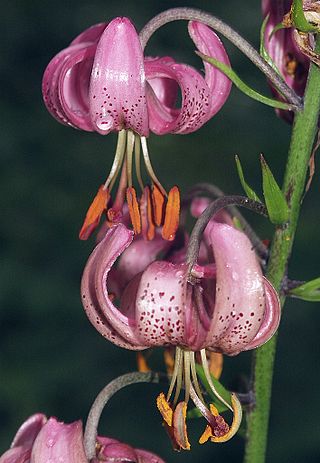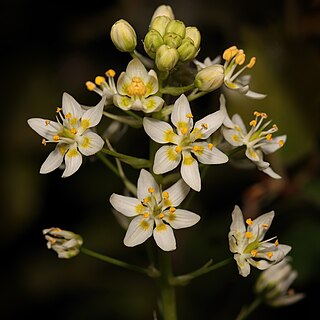
Liliales is an order of monocotyledonous flowering plants in the Angiosperm Phylogeny Group and Angiosperm Phylogeny Web system, within the lilioid monocots. This order of necessity includes the family Liliaceae. The APG III system (2009) places this order in the monocot clade. In APG III, the family Luzuriagaceae is combined with the family Alstroemeriaceae and the family Petermanniaceae is recognized. Both the order Lililiales and the family Liliaceae have had a widely disputed history, with the circumscription varying greatly from one taxonomist to another. Previous members of this order, which at one stage included most monocots with conspicuous tepals and lacking starch in the endosperm are now distributed over three orders, Liliales, Dioscoreales and Asparagales, using predominantly molecular phylogenetics. The newly delimited Liliales is monophyletic, with ten families. Well known plants from the order include Lilium (lily), tulip, the North American wildflower Trillium, and greenbrier.

Smilacaceae, the greenbriers, is a family of flowering plants. While they were often assigned to a more broadly defined family Liliaceae, most recent botanists have accepted the two as distinct families, diverging around 55 million years ago during the Early Paleogene. One characteristic that distinguishes Smilacaceae from most of the other members of the Liliaceae-like Liliales is that it has true vessels in its conducting tissue. Another is that the veins of the leaves, between major veins, are reticulate (net-shaped), rather than parallel as in most monocots.

Melanthiaceae, also called the bunchflower family, is a family of flowering herbaceous perennial plants native to the Northern Hemisphere. Along with many other lilioid monocots, early authors considered members of this family to belong to the family Liliaceae, in part because both their sepals and petals closely resemble each other and are often large and showy like those of lilies, while some more recent taxonomists have placed them in a family Trilliaceae. The most authoritative modern treatment, however, the APG III system of 2009, places the family in the order Liliales, in the clade monocots. Circumscribed in this way, the family includes up to 17 genera.

Melanthieae is a tribe of flowering plants within the family Melanthiaceae. Molecular phylogenetic studies in the 21st century have resulted in a large-scale reassignment of many of its species to different genera; in particular the genus Zigadenus (deathcamases) has been restricted to a single species, Zigadenus glaberrimus. Plants contain alkaloids, making them unpalatable to grazing animals; many are very poisonous to both animals and humans.

Toxicoscordion fremontii, known as the common star lily or Frémont's deathcamas or star zigadene, is an attractive wildflower found on grassy or woody slopes, or rocky outcrops, in many lower-lying regions of California, southwestern Oregon, and northern Baja California.

Fritillaria affinis, the chocolate lily, is a highly variable species of flowering plant in the lily family Liliaceae native to western North America.

Amianthium is a North American genus of perennial plants growing from bulbs. It contains the single known species Amianthium muscitoxicum, known in English as fly poison from a literal translation of the Latin epithet muscitoxicum, and is noted for its pretty flowers and its toxic alkaloid content. While all parts of the plant are poisonous, the bulb is particularly toxic. The scientific epithet was given to it by Thomas Walter when he published his Flora Caroliniana in 1788.

Toxicoscordion venenosum, with the common names death camas and meadow death camas, is a species of flowering plant in the genus Toxicoscordion, of the Melanthiaceae family. It is native to western North America from New Mexico to Saskatchewan and west to the Pacific Ocean.

Anticlea elegans, formerly Zigadenus elegans, is also known as mountain deathcamas, elegant camas or alkali grass. It is not a grass, but belongs to the trillium family, Melanthiaceae.
Deathcamas or death camas refers to several species of flowering plant in the tribe Melanthieae. The name alludes to the great similarity of appearance between these toxic plants, which were formerly classified together in the genus Zigadenus, and the edible camases (Camassia), with which they also often share habitat. Other common names for these plants include deadly zigadene, hog potato and mystery-grass.

Toxicoscordion micranthum, the smallflower deathcamas, is a flowering plant in the genus Toxicoscordion. It is native to Oregon and California, primarily in the Coast Ranges from Douglas County to Napa and Sonoma Counties, with isolated populations in Lassen, Plumas, Santa Clara, and San Benito Counties. It is a member of the serpentine soils flora.

Anticlea is a genus of flowering plants in the family Melanthiaceae, tribe Melanthieae. Molecular phylogenetic studies in the 21st century have resulted in number of changes to placements within this tribe. Anticlea was long submerged into the genus Zigadenus; however its separate position has been confirmed. Some species were also moved from Stenanthium into Anticlea. Members of Anticlea may also be distinguished from other members of the former genus Zigadenus, the deathcamases, by the presence of narrow tepals with a single, conspicuous, bilobed gland. It also has a wider distribution, occurring in Asia and much of North and Central America, ranging south to Guatemala.

Toxicoscordion is a genus of flowering plants in the family Melanthiaceae, tribe Melanthieae, first described as a genus in 1903. The genus is mainly distributed in the midwestern United States and western North America, with some species in western Canada and northern Mexico.

Stenanthium is a North American genus of flowering plants in the tribe Melanthieae of the family Melanthiaceae.

Toxicoscordion nuttallii is a species of poisonous plant native to the south-central part of the United States.

Stenanthium densum is a poisonous but spectacular monocot wildflower native to pine barrens of the eastern United States. It is known variously as Osceola's plume, crowpoison, or black snakeroot. Stenanthium leimanthoides is either treated as a synonym of this species or as a separate species. It is native to the southernmost Gulf Coast, from eastern Louisiana east, down through most of Florida, and to the easternmost Atlantic Coast north to Rhode Island, seldom far from the coast.

Stenanthium leimanthoides is a poisonous monocot wildflower native to acid montane areas of the eastern United States. It is either treated as a separate species to Stenanthium densum or as a synonym of that species. A common name is pine barren deathcamas.
Toxicoscordion fontanum,, common name small-flower death camas, is a rare plant species known only from serpentine marshes in California. It is found primarily in the Coast Ranges from Mendocino County to San Luis Obispo County, with an additional report of an isolated population in the Sierra Nevada foothills in Kern County east of Bakersfield.

Zygacine is a steroidal alkaloid of the genera Toxicoscordion, Zigadenus, Stenanthium and Anticlea of the family Melanthiaceae. These plants are commonly known and generally referred to as death camas. Death camas is prevalent throughout North America and is frequently the source of poisoning for outdoor enthusiasts and livestock due to its resemblance to other edible plants such as the wild onion. Despite this resemblance, the death camas plant lacks the distinct onion odor and is bitter to taste.
Schiedeella arizonica is a species of Orchid native to the Southewestern United States, and Mexico. It was first described by Paul Martin Brown in 2000. This species additionally goes by several common names including fallen ladies tresses, parasitic lady's tresses, and Indian-braids.

















